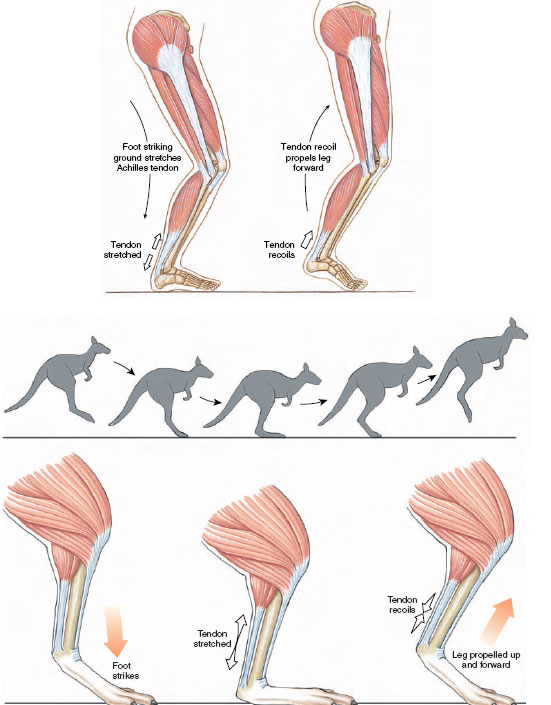Muscle Performance
Muscle Performance
Fast and Slow Fibers
Skeletal muscles of vertebrates consist of more than one type of fiber. Slow fibers, which are specialized for slow, sustained contractions without fatigue, are important in maintaining posture in terrestrial vertebrates. Such muscles are often called red muscles because they contain an extensive blood supply, a high density of mitochondria for supplying ATP, and abundant stored myoglobin which supplies oxygen reserves, all of which give the muscle a red color.
Two kinds of fast fibers, capable of fast, powerful contractions are known. One kind of fast fiber lacks an efficient blood supply and a high density of mitochondria and myoglobin. Muscles made up of these fibers (often referred to as white muscles) are usually pale in color, function anaerobically, and fatigue rapidly. The “white meat” of chicken is a familiar example. The other kind of fast fiber has an extensive blood supply and a high density of mitochondria and myoglobin, and functions largely aerobically. Animals use these for rapid, sustained activities. Most muscles possess a mixture of these different fiber types to provide for a range of activity. Geese, dogs, and ungulates (hoofed mammals), for example, have limb (or wing) muscles with a high percentage of fast aerobic fibers, and are capable of active locomotion for long periods of time. Members of the cat family, however, have running muscles made up almost entirely of fast fibers that operate anaerobically. During a chase, such muscles build up a substantial oxygen debt that is replenished after the chase. For example, a cheetah after a high-speed chase lasting less than a minute, will pant heavily for 30 to 40 minutes before its oxygen debt is paid off.
Importance of Tendons in Energy Storage
When mammals walk or run, much kinetic energy is stored from step to step as elastic strain energy in the tendons. For example, during running the Achilles tendon is stretched by a combination of downward force of the body on the foot and contraction of the calf muscles. The tendon then recoils, extending the foot while the muscle is still contracted, propelling the leg forward (Figure 31-19). An extreme example of this bouncing ball principle is the bounding of a kangaroo, which essentially bounces along on its tendons, utilizing the effect of gravity (Figure 31-19). This type of movement uses far less energy than would be required if every step relied solely on alternate muscle contraction and relaxation.
There are many examples of elastic storage in the animal kingdom. It is used in the ballistic jumps of grasshoppers and fleas, in the wing hinges of flying insects, in the hinge ligaments of bivalve molluscs, and in the highly elastic large dorsal ligament (ligamentum nuchae) that helps support the head of hoofed mammals.
Fast and Slow Fibers
Skeletal muscles of vertebrates consist of more than one type of fiber. Slow fibers, which are specialized for slow, sustained contractions without fatigue, are important in maintaining posture in terrestrial vertebrates. Such muscles are often called red muscles because they contain an extensive blood supply, a high density of mitochondria for supplying ATP, and abundant stored myoglobin which supplies oxygen reserves, all of which give the muscle a red color.
Two kinds of fast fibers, capable of fast, powerful contractions are known. One kind of fast fiber lacks an efficient blood supply and a high density of mitochondria and myoglobin. Muscles made up of these fibers (often referred to as white muscles) are usually pale in color, function anaerobically, and fatigue rapidly. The “white meat” of chicken is a familiar example. The other kind of fast fiber has an extensive blood supply and a high density of mitochondria and myoglobin, and functions largely aerobically. Animals use these for rapid, sustained activities. Most muscles possess a mixture of these different fiber types to provide for a range of activity. Geese, dogs, and ungulates (hoofed mammals), for example, have limb (or wing) muscles with a high percentage of fast aerobic fibers, and are capable of active locomotion for long periods of time. Members of the cat family, however, have running muscles made up almost entirely of fast fibers that operate anaerobically. During a chase, such muscles build up a substantial oxygen debt that is replenished after the chase. For example, a cheetah after a high-speed chase lasting less than a minute, will pant heavily for 30 to 40 minutes before its oxygen debt is paid off.
Importance of Tendons in Energy Storage
When mammals walk or run, much kinetic energy is stored from step to step as elastic strain energy in the tendons. For example, during running the Achilles tendon is stretched by a combination of downward force of the body on the foot and contraction of the calf muscles. The tendon then recoils, extending the foot while the muscle is still contracted, propelling the leg forward (Figure 31-19). An extreme example of this bouncing ball principle is the bounding of a kangaroo, which essentially bounces along on its tendons, utilizing the effect of gravity (Figure 31-19). This type of movement uses far less energy than would be required if every step relied solely on alternate muscle contraction and relaxation.
 |
| Figure 31-19 Energy storage in the Achilles tendon of human and kangaroo legs. During running, stretching of the Achilles tendon when the foot strikes the ground stores kinetic energy that is released to propel the leg forward. |
There are many examples of elastic storage in the animal kingdom. It is used in the ballistic jumps of grasshoppers and fleas, in the wing hinges of flying insects, in the hinge ligaments of bivalve molluscs, and in the highly elastic large dorsal ligament (ligamentum nuchae) that helps support the head of hoofed mammals.




